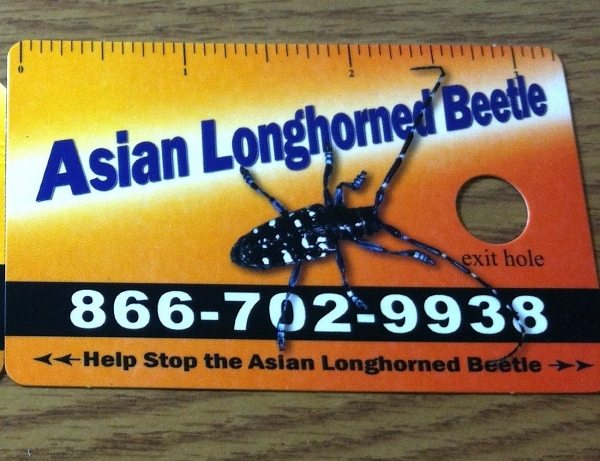BRATTLEBORO — August's warm weather brings many people outside for hiking, picnicking, or just spending time in the yard.
Asian long-horned Beetles like to come out, too.
That is why the U.S. Department of Agriculture (USDA) has declared August “Tree Check Month,” to help detect and eradicate the infestation of the damaging insect.
“August is the time of year when adult beetles are emerging” from inside infested trees, said USDA Public Affairs Specialist Rhonda Santos.
As larvae, they burrow deep inside tree trunks, eating the wood inside, turning it into what Santos compares to a slice of Swiss cheese.
Beginning in July, and peaking in August, the grown-up beetle come out of the tree, often to travel to another tree, where it will eventually kill it.
“It takes three-to-four years for a tree to decline,” from the initial point of infestation, Santos said.
Although no Asian long-horned beetle have been detected in the state, Santos said the USDA takes seriously Vermont's close proximity to states with major infestations.
And so should we.
Windham County's “close proximity to Massachusetts is a concern,” Santos said, noting the active infestation located about 90 miles away.
In the city of Worcester, an infestation was first discovered when “a woman reported strange insects in her trees,” Santos said. The woman went online to see what the bugs were, and then called the USDA.
“Worcester County, Massachusetts, lost over 34,000 trees” to the Asian long-horned beetle, Santos said. The infestation there lasted more than a decade.
“The beetle doesn't know state boundaries, it'll just keep going,” she said.
Santos noted the Asian long-horned beetle's preferred tree: maple.
“It would be terrible for Vermont to have an infestation,” she said.
Because Windham County sees many travelers, being the first stop on Interstate 91, it is arguably the most at-risk part of the state.
“One way the insect travels is from folks bringing firewood for camping and vacations” from infested areas, Santos said.
Although the beetle needs live trees to live, it can move into a new area inside cut wood.
The prevailing theory, Santos said, is the insect first entered the United States in the mid-1980s through Brooklyn's shipping ports. “It probably came in on solid wood packing materials,” she said, noting “we found exit holes in pallets."
By 1996, Brooklyn's trees hosted the country's first known infestation.
From there it traveled to the rest of New York and New Jersey, but the latter state has successfully eradicated the beetle from its trees. Ohio and Illinois have also been affected, but the USDA, on its website, declares “all states are at risk."
In New York City, the USDA and the U.S. Forest Service designed a little card, about the size of a credit card, as part of their public campaign to get citizens to spot the Asian long-horned beetle. The card has the USDA's contact info, ruled lines showing the general size of the adult beetle, and a hole punched through the card with the typical size of the exit hole found on tree trunks.
Locally, one can find these cards in the lobby of Putney's Town Hall.
Detection, before it's too late
“The best way to be proactive and preventative is to check trees in your own yards and on walks,” Santos said.
“Look for a perfectly round hole in the tree, just smaller than a dime,” she explained, or the adult insect crawling around on the tree's exterior.
The USDA's website also suggests people look for dead branches, shallow scars in the bark, and sawdust-like material on the ground beneath the tree or on branches.
If you think you found an Asian long-horned beetle, or evidence of its infestation in trees, call 866-702-9938. Santos said that number rings directly to the White River Junction office of Stephen Lavallee, acting state plant health director with the USDA's Animal and Plant Health Inspection Service.
The USDA has also set up a website to report possible sightings, asianlonghornedbeetle.com.
Santos, who triages suspected sightings sent through the website, encourages people to send pictures, if possible, with their reports.
And do it quickly.
Early detection - including removing the tree and destroying it, and the larvae and adult beetles within - will help protect neighboring trees.
“It's really devastating when the insect is left to flourish,” Santos said.
“There's no way to cure the tree. The tree has to be removed,” she added.
“Insecticide can't get to the larvae. The larvae live inside the tree, and insecticide can't reach them,” she said. “It's a sad situation for the tree."
